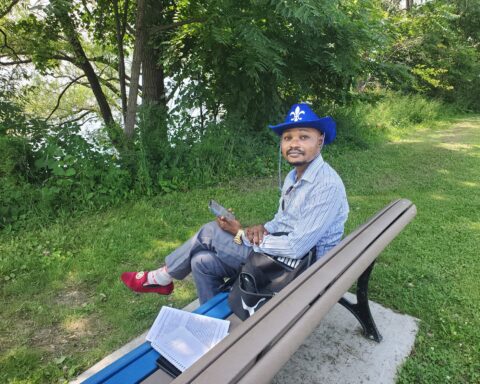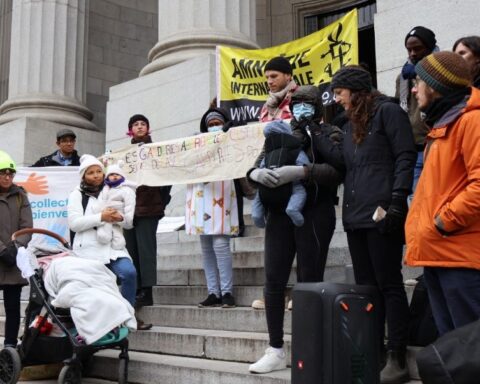Honour on Trial: The Shafia Murders and the Culture of Honour Killings – by Paul Schliesmann, Fitzhenry & Whiteside, 2012, 207 pages
Without Honour: The True Story of the Shafia Family and the Kingston Canal Murders – by Rob Tripp, HarperCollins, 2012, 348 pages
It’s been a year since the Shafia trial concluded in Kingston, sending an immigrant father, mother and their eldest son to prison for killings in the name of “family honour”. They were found guilty of the murders of three girls from the family and another woman who turned out to be the patriarch’s second wife.
This was a trial that riveted the attention of Canadians, who were caught up with this immigrant soap opera: A successful businessman from Afghanistan, his two wives, chic daughters, a domineering brother, and a value system that seemed to emphasize honour above life. Two award-winning journalists who covered the trial, Rob Tripp and Paul Schliesmann, have captured the story in very different books.
Tripp offers the far more textured and graphic story, focusing less on the crime itself and devoting his research and interviewing skills to situating the lives of Zainab (19), Sahar (17), Geeti (13) and their father’s first wife, Rona (50). The fact that the girls had a difficult transition to high school life in Canada is beyond doubt: they had an overbearing brother in Hamed; their largely-absent father Mohammad was given to fits of rage and cursing in Dari; and their mother Tooba came across more as a bystander than a parent in the family.
Schliesmann’s is the more reportorial endeavour, the straight story told with essential detail, and based largely on court proceedings. It is hence a quicker read, and very helpfully, has a section on other honour killings in Canada and a chapter titled “The lessons…” about how institutions in Montreal (where the Shafias lived) were ill-equipped to deal with the extremely raucous household in their midst. Had they acted, these deaths could have been avoided.
Here is just a sampling of the kind of situations this Afghan immigrant family faced during the two years they were together in Canada (before June 2009): school authorities informing the parents that the kids were late to school, performing poorly or routinely absent; the children running away from home and seeking shelter elsewhere; the kids calling in child protection service officers and then recanting their stories of physical abuse and intimidation in the presence of their parents; and finally, a girl deciding to get married and then changing her mind right after and pronouncing “talaq” (the Arabic word for divorce) in front of the very same Muslim cleric. Amid this maelstrom of immigrant life, the two elder girls – Zainab and Sahar – had blooming love relationships, sometimes texting naughty nothings to two boyfriends simultaneously.
At one level, this was a highly successful immigrant family. They were already millionaires and were building a 6,000 sq. ft. home in the exclusive Montreal suburb of Brossard at the time of the horrific deaths in the Rideau Canal. The kids had been schooled in English and French. Despite their erratic attendance and lacklustre grades at school, one has to only read transcripts of the testimony of one of the four surviving Shafia children who was 15 at the time of the deaths (Tripp calls him “Zafar,” although they cannot be identified given their age) to see how they could come across as well-adjusted and confident. [It is logical to ask, then, why they did not squeal on their parents.]
To wit, this young man, 17 at the time of his testimony, had this exchange with a prosecutor, as reported by Schliesmann –
Prosecutor: “Where do you draw the line on manipulating people and telling lies?”
Zafar: “When it goes too far, I guess.”
This response and several other similar smart-aleck retorts earned this observation from the lead prosecutor: “Where your memory has improved, it’s all to the benefit of your mom and dad and Hamed. Where your memory hasn’t improved are [the] things that aren’t helpful to your parents.”
The two books make clear that the convictions were won on the basis of compelling circumstantial evidence, conflicting statements to the police and testimony by the accused and the theory that the Shafia household believed in “honour killings” to redeem their family reputation. The notion of “honour killings” was central and it is therefore no coincidence that both the authors use the word Honour in their titles – it is the convenient label that intrigues Canadians, a concept so alien and so loathsome that most Canadians would agree with the verdict of the 12-member jury.
Yet, like all short hand, it is simplistic. There are nuances one can glean from the books that make the Shafia family dynamic a highly complex immigrant situation, one that defies easy characterization. Here are some of them –
· Their cultural mores were not driven by their Muslim faith. They did not attend mosque and had trouble finding a priest to conduct their daughter’s hastily-arranged wedding.
· Although they had relatives in Montreal, the Afghan community there is divided over whether these were indeed honour killings. Essential to the notion of honour is the need to “save face” from the community. They weren’t really connected to the small Afghan community there given that the father was away most of the year.
· Tooba, the mother of all the children, did not wear a hijab (veil).
· Canada was home-country number five, after Afghanistan, Pakistan, Dubai (U.A.E.) and Australia. Shafia’s business was based in Dubai, so why did he choose to have his family in a liberal country like Canada, and more specifically, the laissez-faire province of Quebec?
· It does not look like the parents were against dating. Even before they arrived in Canada, the parents had told the children that they were not allowed to date or marry until they finished school. It is unclear whether that meant high school or university.
· From all accounts, Shafia appeared to be an indulgent father. He was away most of the time and his son Hamed took charge of things while he was away. This, despite the constant conflict in the household.
· He and his wife couldn’t have been unaware that his girls wore figure-hugging and revealing clothes and were attending co-ed schools. In Dubai, the elder kids had attended an English-medium American school, hardly the most conservative option available there. (According to the Tripp book, Zainab, Sahar and Geeti attended the Al Sadiq Islamic English School in Dubai.)
· Shafia himself claimed he did not believe in “honour killings” and several of his family members said in court that they had never heard of the practice until the Kingston deaths. In his own defence, Shafia said during testimony at the trial: “For me, anyone who kills a child or daughter, that person really becomes shameless… I don’t call that honour.”
Both Tripp and Schliesmann do a commendable job laying out all the evidence, describing the tensions within the Shafia household and providing the backdrop for this self-incriminating nugget from the family patriarch during a family coversation: “There is nothing more valuable than honour. I am telling you now and I was telling you before that whoever play[s] with my honour, my [answer is] the same … There is no value of life without honour.”
We don’t know what Shafia really believes, but surely, we have not heard the last from him or his wife or his son. We still don’t know how exactly the murders were committed. As the Shafias appeal their 25-year life sentences, we can expect Schliesmann and Tripp to follow the case and continue informing us about the cautionary tale that this family engenders for Canadian immigration.




